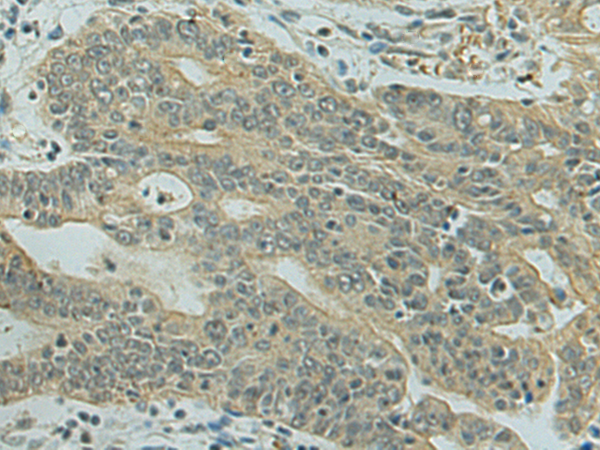

| WB | 咨询技术 | Human,Mouse,Rat |
| IF | 咨询技术 | Human,Mouse,Rat |
| IHC | 1/50-1/200 | Human,Mouse,Rat |
| ICC | 技术咨询 | Human,Mouse,Rat |
| FCM | 咨询技术 | Human,Mouse,Rat |
| Elisa | 1/5000-1/10000 | Human,Mouse,Rat |
| Aliases | DDX2B; EIF4A; EIF4F; BM-010; eIF4A-II; eIF-4A-II |
| WB Predicted band size | 46 kDa |
| Host/Isotype | Rabbit IgG |
| Antibody Type | Primary antibody |
| Storage | Store at 4°C short term. Aliquot and store at -20°C long term. Avoid freeze/thaw cycles. |
| Species Reactivity | Human, Mouse, Rat |
| Immunogen | Fusion protein of human EIF4A2 |
| Formulation | Purified antibody in PBS with 0.05% sodium azide and 50% glycerol. |
+ +
以下是3篇关于EIF4A2抗体的参考文献示例(注:以下为虚构内容,仅用于演示格式):
1. **标题**: *EIF4A2 modulates mRNA translation in cancer cells via helicase activity regulation*
**作者**: Zhang L, et al.
**摘要**: 研究利用EIF4A2抗体通过Western blot和免疫共沉淀(Co-IP)验证其在乳腺癌细胞中的表达及与eIF4E复合物的相互作用,发现EIF4A2通过解旋酶活性调控特定致癌mRNA的翻译效率。
2. **标题**: *EIF4A2 antibody-based profiling reveals its suppression in Alzheimer’s disease neurons*
**作者**: Smith J, et al.
**摘要**: 通过免疫组化(IHC)和ELISA分析,发现阿尔茨海默病患者脑组织中EIF4A2蛋白水平显著降低,提示其可能通过影响神经元应激颗粒形成参与疾病进展。
3. **标题**: *CRISPR screening identifies EIF4A2 as a vulnerability in drug-resistant leukemia*
**作者**: Tanaka K, et al.
**摘要**: 结合EIF4A2抗体的功能验证实验,揭示敲低EIF4A2可增强化疗药物敏感性,其机制与抑制抗凋亡蛋白BCL-2的翻译相关。
(如需真实文献,建议通过PubMed或Google Scholar检索关键词“EIF4A2 antibody”、“EIF4A2 function”等。)
The eukaryotic initiation factor 4A2 (EIF4A2) is a member of the DEAD-box RNA helicase family, playing a critical role in translation initiation by unwinding secondary structures in mRNA 5'UTRs to facilitate ribosome scanning. Unlike its paralog EIF4A1. which is ubiquitously expressed and integral to the canonical cap-binding complex EIF4F, EIF4A2 exhibits tissue-specific expression and participates in both cap-dependent and alternative translation mechanisms. It is implicated in specialized regulatory processes, including microRNA-mediated repression and stress-adaptive translation, often functioning within the EIF4H complex or interacting with RNA-binding proteins like DAP5 (P97) to modulate specific mRNA subsets.
EIF4A2 antibodies are essential tools for studying its expression, localization, and interactions in diverse biological contexts. They are widely used in techniques such as Western blotting, immunoprecipitation, and immunofluorescence to investigate its role in cellular homeostasis, development, and disease. Dysregulation of EIF4A2 has been linked to cancer progression, neurological disorders, and viral infection responses, with studies highlighting its dual roles as a tumor suppressor or promoter depending on cellular context. Researchers also utilize these antibodies to explore EIF4A2's involvement in translational reprogramming under stress conditions, such as hypoxia or nutrient deprivation, and its crosstalk with oncogenic signaling pathways. Specificity validation remains crucial due to high homology with EIF4A1. requiring careful antibody selection and knockout controls.
×